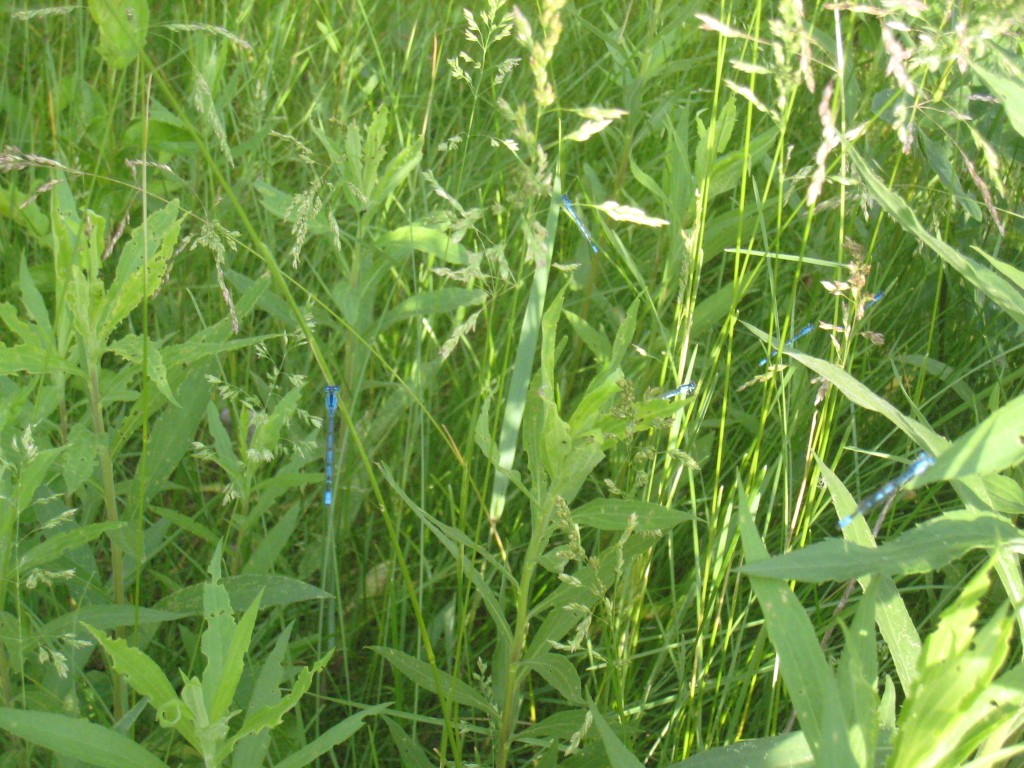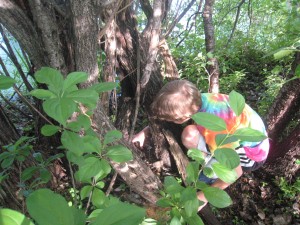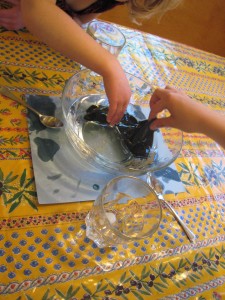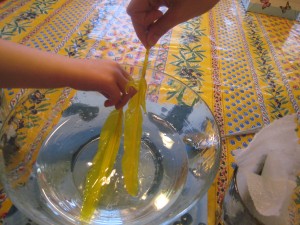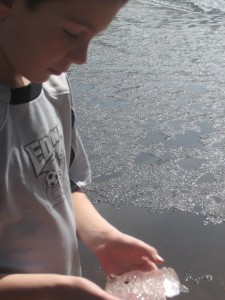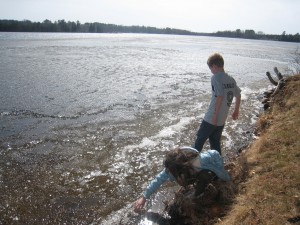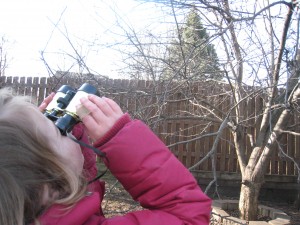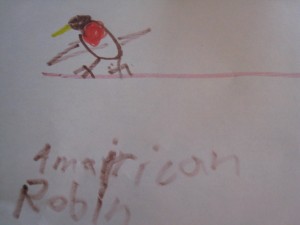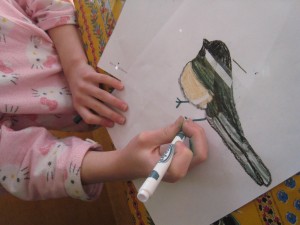Category:The World Around Us’
Cry, Baby, Cry
- by KitchenPantryScientist
Drill, Baby, Drill. I Cry because tar balls soil white sand.
Drill, Baby, Drill. I Cry for brown pelicans, drowning in oil.
Drill, Baby, Drill. I Cry for the fisherman, losing all hope.
Drill, Baby, Drill. I Cry for the Loons that soon will head South.
I Cry for the turtles.
I Cry for the birds.
I Cry for the fish and the crabs and the snails.
Drill, Baby, Drill.
I Cry for us all and our insatiable need.
For large automobiles and huge houses and things.
I Cry for the world we’ve so casually wrecked.
Cry, Baby, Cry.
Nature on the Periphery
- by KitchenPantryScientist
My son insisted on bring his GPS to soccer last night to look for geocaches in the park. I grudgingly agreed, thinking it would be easier for me to sit by the playground.
We followed him to the woods on the edge of the manicured fields where we discovered a world of damselflies and caterpillars hiding in the weeds. He searched for the cache deeper in the trees while my four-year old pointed out beetles and found one “pink” damselfly among the hundreds of blue ones.
I love it when my kids lead me to places I never would have even thought to look.
My posts will be spotty over the next few weeks as we finish the school year and ease into summer.
Oil Spill Experiment
- by KitchenPantryScientist
The oil spill in the Gulf of Mexico is devastating news to the already fragile and damaged ecosystems in the area. To demonstrate how hard it is to remove oil from water, and what materials work best, I found this experiment online at tryscience.org and decided to have my kids try it. It was messy and disgusting and oil got all over everything. In other words, it was a great demonstration of how hard it will be to clean up the mess made by BP’s Deepwater Horizen oil rig, which exploded on April 20th.
You’ll need a clear bowl, water, yellow oil (vegetable, corn or canola will work,) cotton balls, cheese cloth, polyester cloth (the website said polypropylene, but I couldn’t find any,) feathers, and a spoon.
Put some water in the bowl and pour in some oil. I probably added a cup so it would cover the water. Then, using spoons and the other materials, try to remove the oil from the water. What works best?
We put our feathers in oil and then tried to clean them off using dish soap and water, which is how they clean off marine birds covered with oil following oil spills.
Polypropylene is a synthetic material made from Carbon and Hydrogen, the same elements in oil. Oil is attracted to polypropylene, and both float on water, so polypropylene is often used in cleaning up oil spills. You can also find it in gloves and sock liners.
If one cup of oil is this hard to clean up, can you imagine the mess pouring into the Gulf of Mexico right now, at the rate of about 210,000 gallons a day (according to the New York Times?) I’m attempting to find out if there’s any way to help, aside from travelling to the area to help clean off wildlife by hand. As soon as I learn anything, I’ll post it here! Here is a link to a map that is tracking the spill.
Wonder
- by KitchenPantryScientist
I’m reading “Einstein’s God” by Krista Tippet right now, and came upon this great autobiographical account by Albert Einstein. It seems that he had a childlike wonder about the world that lasted well into adulthood and helped him to become a great thinker.
“Why do we come, sometimes spontaneously, to wonder about something? I think that wondering to one’s self occurs when an experience conflicts with our fixed ways of seeing the world. I had one such experience of wondering when I was a child of four or five and my father showed me a compass. This needle behaved in such a determined way and did not fit into the usual explanation of how the world works. That is that you must touch something to move it. I still remember now, or I believe that I remember, that this experience made a deep and lasting impression on me. There must be something deeply hidden behind everything.”
Krista then writes, “After seeing that compass, Einstein became mesmerized in turn by light and gravity. He spent his life seeking to comprehend the order “deeply hidden behind everything” and to describe it mathematically.”
What have you wondered about lately?
Lake Ice Going Out- Cool Crystals
- by KitchenPantryScientist
We were up at the lake last week when the ice went out. It was amazing. We arrived at noon to a lake whose surface was half covered with ice and woke the next morning to clear water. The wind was blowing the ice into shore and it broke into millions of crystals that sounded like a field of windchimes. The crystals were so sharp that our dog cut his foot.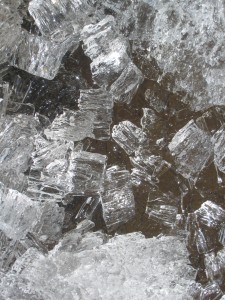
If you’re interested, you can watch the very wobbly, but cool video I took of the ice blowing around. You can see the ice crystals being pushed up and out of the water into piles. Listen, and you’ll hear the ice crystals clinking together!
[vsw id=”qt9HKExG2To” source=”youtube” width=”425″ height=”344″ autoplay=”no”]
This week, the kids and I are going to grow alum and sugar crystals, so be sure to check for the upcoming post!
Backyard Birding
- by KitchenPantryScientist
The weekend started off when I took our four-year old to see the movie “How to Train Your Dragon” (I think I liked it as much as she did) and left the theater talking about what it would be like to fly. We did a craft project, taking a butterfly from egg to wings, and toppped Sunday off by going for a bird-watching walk through the neighborhood and nearby woods.
With the arrival of spring in Minnesota, birds are everywhere! Cardinals are singing outside as I type. On our walk, we saw dozens of robins and woodpeckers. A hawk soared over and a nearby crow cawed at a Turkey Buzzard that soared down too close to his meal. I knew it was a buzzard because it was entirely black and I recognized the shape of its wingtips.
Do you know how to tell what kind of bird you’re looking at? The study of birds is called Ornithology and bird watching can be fun for all ages.
Why not go on a bird walk with your kids? Take a bird guide, if you have one, a notebook (their science notebook would be perfect) or a piece of paper and write down or draw what the birds you see look like. Binoculars would be great too, but aren’t necessary. Be sure to notice what color the birds you see are, special markings they might have, how big they are, and how their wings are shaped. You can even memorize or record how their song sounds. Do they sing “chick-a-dee-dee-dee” or “who-cooks-for-you?” If you feel like it, count how many robins or cardinals you see!
When you get home from your walk, you can use a Bird Identification book to look up your discoveries, or you can go online and use one of the many, interactive resources there. I decided to use whatbird.com and allaboutbirds.org from the Cornell Lab of Ornithology, to try to identify the hawk that we saw. Although I thought it was a red-tail hawk, I wasn’t sure. Both websites were helpful. Whatbird.com offered a visual search, where you could choose from different fields, like color and wing shape to narrow your identification. It worked pretty well, but didn’t seem foolproof. Allaboutbirds.org had a field where you could search birds by name and shape, which had nice photos you could use to identify what you had seen. Your kids could even make a guide of birds in your area!
So get those kids outside and let them hone their observations skills! No one offers a better show at a better price than Mother Nature!
Sky Gazing
- by KitchenPantryScientist
If the sky is clear tonight (Friday, Jan.29,) be sure to look up. Not only will the moon be full, but Mars will be visible close by (about a fist’s length) and appear red to the naked eye as it comes within 62 million miles from earth and lines up opposite the sun. Read more here.
Hungry or Starving?
- by KitchenPantryScientist
Last night, as 39 of my fellow Minnesota bloggers and I gathered to pack food for “Feed My Starving Children” , we were asked the question, “what is the difference between hungry and starving?” The dictionary defines hunger as experiencing a desire or need for food, while starving is defined as: to suffer or die from extreme or prolonged lack of food. In fact, when you are starving, your body actually begins metabolizing, or eating itself. If you don’t get food, you will die. The only way to reverse the process is to give a starving body nutrients with which to rebuild itself.
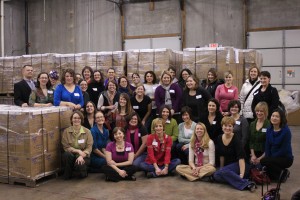
We mixed together soybeans, chicken-flavored vitamins, vegetables and rice in small plastic bags to be sent to another country, possibly Haiti, to feed starving people. People like us. Children like our children. Together, in less than an hour, our group, along with three or four others, packed 13,824 meals: enough food to feed 38 people for a year. It is astonishing that so little effort can change, and possibly even save, so many lives. To learn more about Feed My Starving Children and how you can help, visit their website.
